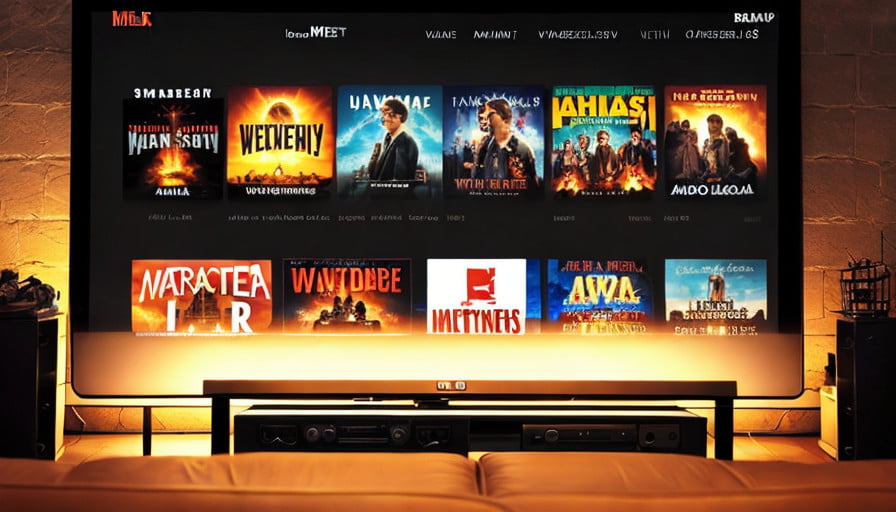Streaming services have revolutionized the way we consume media in recent years. It has become increasingly popular for people to watch movies, TV shows, and other forms of media through streaming platforms such as Netflix, Amazon Prime Video, Hulu, Disney+ and others. But what exactly are streaming services?
Streaming services refer to platforms that provide users with on-demand access to a variety of digital content over the Internet. This means that users can watch movies and TV shows in real-time without having to download them first.
Instead, these services allow users to stream content directly to their devices from a remote server. The film industry has undergone many changes throughout history.
From silent films to talkies, black and white pictures to technicolor spectacles, and drive-ins to multiplex cinemas – it has evolved significantly over time. The movie-going experience has always been considered a unique experience for viewers who gather together in theaters or other venues where they can enjoy films on a large screen with high-quality audio.
The impact that streaming services have had on the film industry is undeniable. This article will explore how these services have changed both the production and distribution of films, as well as how audiences consume them today.
The Evolution of Streaming Services: A Brief History
Streaming services began gaining popularity in the early 2000s as Internet speeds increased and technology improved for delivering video content online. Companies like Netflix started out by offering DVD rentals by mail but quickly expanded into streaming video-on-demand (VOD) service with its own original programming.
Today there are various major players in this market including Netflix, Amazon Prime Video, Hulu, HBO Max Disney+ amongst many others all vying for attention from consumers.
One key reason for their popularity is the convenience they offer to viewers. With streaming services, users can watch what they want, when they want and where they want.
This accessibility has made streaming services a preferred choice over traditional TV channels or movie theaters. The rise of streaming services has disrupted the traditional model of media consumption and ushered in a new era in which people have more control over the content they consume.
The Impact of Streaming Services on the Film Industry
Streaming services have had a profound impact on the way films are produced, distributed and consumed today. In terms of production, many filmmakers now produce content specifically for streaming services.
The appeal of these platforms is significant because they offer more creative freedom and flexibility than traditional studios do. Streaming services have also impacted distribution models by challenging the dominance of traditional movie theaters.
For instance, Netflix has released movies that bypass theatrical release entirely and go straight to its platform for viewing. This approach has been controversial within the industry, but it illustrates how streaming has created new opportunities for filmmakers to reach audiences directly.

There is no denying that streaming services have changed audience behaviour as well. People now prefer watching movies at home over going to theaters because of their busy schedules or simply because it’s more convenient to watch from home.
There’s no doubt that streaming services have changed the game for the film industry significantly in recent years. They provide viewers with greater flexibility and choice in terms of what they watch and when they watch it, offer filmmakers new avenues for creativity, and challenge traditional distribution models altogether.
You may also be interested in reading this article we wrote about: Challenges Facing Film Industry Today: Navigating Obstacles to learn more about the industry.
The Rise of Streaming Services
Overview of Major Streaming Services
The emergence of streaming services such as Netflix, Amazon Prime, Hulu, and Disney+ has revolutionized the way people consume media. These platforms offer a vast selection of movies and TV shows that can be accessed on-demand from any device with an internet connection.
Netflix has been the trailblazer in this field, having started as a DVD-by-mail service before transitioning to streaming in 2007. Today, it boasts over 208 million subscribers worldwide.
Amazon Prime Video and Hulu have also gained significant traction in recent years, while Disney+ is quickly becoming a major player after launching in late 2019. Each streaming service has its unique offerings and strategies.
For example, Netflix produces original content while still licensing movies and TV shows from other studios. Meanwhile, Amazon Prime Video is part of a larger subscription package that includes free shipping on Amazon purchases.
Hulu offers access to current episodes of popular TV shows the day after they air on television. Disney+, which focuses primarily on family-friendly content, includes exclusive titles such as Star Wars: The Mandalorian and Marvel’s WandaVision.
Statistics on the Growth and Popularity of Streaming Services
The growth of streaming services has been nothing short of phenomenal. According to Statista, the number of global SVOD (subscription video on demand) subscribers reached 1 billion in 2020 – up from just 25 million in 2010. Moreover, it is projected that this number will continue to grow at a compound annual growth rate (CAGR) of over 10% between 2021-2025.
In terms of market share among major players within the industry, Netflix leads with around two-thirds (66%) as per Datareportal’s Global Digital Overview report for January 2021; followed by Amazon Prime at around one-fifth (20%) and Hulu at just over one-tenth (11%). Disney+ has only been in the game for a short time, but its subscription base grew to 116 million in less than two years after launching.
Comparison to Traditional Movie Theaters and Rental Stores
The rise of streaming services has caused significant disruption to the traditional movie theater and rental store business models. With streaming services offering access to a vast library of content at a monthly subscription fee, it has become increasingly challenging for theaters to compete.
Moreover, the COVID-19 pandemic accelerated this trend as theaters were closed around the world, leading studios to release movies directly on streaming services. Similarly, rental stores such as Blockbuster have struggled to keep up with the convenience of online streaming.

Blockbuster filed for bankruptcy in 2010, leaving just one store remaining in Bend, Oregon. This contrasts greatly with Netflix’s success story – having disrupted its DVD-by-mail model and evolved into one of the largest media companies globally with an impressive revenue stream.
Major streaming services have seen exponential growth over recent years with no signs of slowing down. They offer convenience and accessibility that traditional models cannot match.
In contrast, theaters have struggled to adapt while rental stores have all but disappeared from our daily lives. Streaming services are here to stay – making their impact felt on an industry that was once thought untouchable.
The Impact of Streaming Services on Film Production
Shift towards Producing Content for Streaming Services
One of the most significant changes that streaming services have brought to the film industry is a shift in production priorities. More and more films are now being produced with streaming services in mind, rather than traditional theatrical releases. This new paradigm has led to major changes in how movies are made, marketed, and distributed.
This shift towards producing content for streaming services has several advantages. For one, it allows companies like Netflix and Amazon Prime to offer exclusive content that cannot be found elsewhere.
This exclusivity can help these platforms stand out from their competitors and attract more subscribers. Additionally, producing content specifically for streaming services allows filmmakers to explore new creative avenues that might not have been possible with a traditional theatrical release.
Impact on Film Budgets and Production Schedules
The rise of streaming services has also had a significant impact on film budgets and production schedules. Because there is less pressure to produce films that will perform well at the box office, studios can take more risks with their projects. This has led to an increase in the number of mid-budget films being produced, as well as a rise in demand for independent filmmakers.
However, this new model also means that studios are no longer able to rely on ticket sales as their primary source of income. Instead, they must rely on licensing deals with streaming platforms or other sources of revenue such as merchandising or product placements.
Opportunities for Independent Filmmakers
Perhaps one of the most significant impacts that streaming services have had on film production is the opportunities they provide for independent filmmakers. With more platforms hungry for high-quality content than ever before, there has never been a better time for independent filmmakers to break into the industry. Streaming services offer an alternative path to distribution that sidesteps the traditional Hollywood system.
This means that independent filmmakers can focus more on making great movies and less on navigating the politics of studio executives and movie theater chains. Additionally, streaming services often offer filmmakers more creative freedom since they are not beholden to box office expectations.

Overall, while the shift towards producing content for streaming services has certainly led to changes in the film industry, it has also opened up new opportunities for both established studios and independent filmmakers alike. As streaming continues to grow in popularity, it will be interesting to see how this new model continues to evolve and impact the way films are made and distributed.
The Disruption of Traditional Distribution Models
The rise of streaming services has disrupted the traditional distribution models within the film industry. Previously, studios would release films in a tiered distribution system, with films being released first in theaters, then moving to DVD and Blu-ray sales and rentals.
However, with the increased popularity of streaming services, this model has been turned on its head. Now, many studios are releasing films directly to streaming platforms rather than waiting for a theatrical release.
This has created new opportunities for filmmakers who may have struggled to get their films into theaters in the past. However, it has also led to concerns about the long-term viability of movie theaters.
Increased Competition Among Studios and Distributors
The rise of streaming services has also led to increased competition among studios and distributors. With so many different platforms vying for subscribers’ attention, there is more pressure on studios to create high-quality content that will stand out from the crowd.
This competition has also driven up prices for popular content. For example, Netflix paid $100 million to license Friends from WarnerMedia in 2018 – an enormous sum that just a few years ago would have been unheard of.
As more and more companies enter the streaming market (such as Disney+), we can expect this competition to continue intensifying in the coming years. This could be good news for consumers, as it will result in more high-quality content being produced across multiple platforms.
The Impact on Box Office Revenue
Perhaps most significantly, the rise of streaming services has had a major impact on box office revenue within the film industry. In recent years, we’ve seen a decline in movie theater attendance as more people opt to stay home and stream movies instead.
This shift towards home entertainment has hit some films harder than others – for example, big-budget blockbusters still tend to do well at the box office, while smaller indie films may struggle to find an audience in theaters. However, the overall trend is clear: fewer people are going to the movies than they used to.
This has led some industry insiders to predict that movie theaters will become a thing of the past within a few decades. However, others point out that there will always be a demand for the communal experience of going to the movies, and that theaters will continue to thrive alongside streaming services for years to come.
Changes in Audience Behavior
Increased accessibility to films through streaming services
One of the most significant changes in audience behavior due to the rise of streaming services is the increased access to films that were once difficult or impossible to find. With platforms like Netflix and Amazon Prime, viewers can now watch movies from all over the world without having to leave their homes or rely on a specialized theater.
This has led to a boom in interest for foreign films and independent cinema, which were previously niche markets. Streaming services have also made it easier for filmmakers who might not have had traditional distribution channels available to them to reach broader audiences.
Shifts in viewing habits and preferences
The convenience of streaming services has also led to significant shifts in viewer habits and preferences. Many people now prefer watching movies at home because they can pause, rewind, or fast forward with ease.

Some viewers also prefer binging entire seasons of shows rather than waiting week-to-week for new episodes on traditional TV networks. Moreover, as more people watch movies on smaller screens like smartphones and tablets, there is a growing demand for content optimized for mobile devices.
Impact on movie theater attendance
As more people opt for streaming services, traditional movie theaters have seen a decline in attendance. In 2018 alone, movie theater attendance dropped by 6% compared with the previous year (source: Statista).
The convenience of staying home coupled with increasingly high ticket prices means that many people are less likely to go out to see a movie at the cinema unless it’s something they really want to experience on the big screen like an action-packed blockbuster or an epic sci-fi adventure.
Streaming services have contributed significantly towards changes in audience behavior by providing increased accessibility options enabling viewers’ flexibility in their viewing habits and thereby impacting traditional cinema halls’ attendances significantly.
It remains unclear how the future of movie-watching will shape up with streaming services’ rise, but it is clear that the new ways of accessing content have made a significant impact on the industry.
The Future of the Film Industry with Streaming Services
Predictions for future changes in film production, distribution, and audience behavior
The rise of streaming services has already disrupted the traditional movie industry, and it’s safe to say that this trend is not going away anytime soon. In fact, experts predict that the impact of streaming services will continue to grow in the coming years. One prediction is that we will see a shift towards more personalized content, where consumers can choose what they want to watch based on their individual preferences and tastes.
This could mean a surge in niche content, as streaming services cater to specific groups of viewers. Another prediction is that there will be an increase in international collaborations and co-productions.
As streaming services become available all over the world, there will be more opportunities for filmmakers from different countries to work together. This could lead to a rise in cross-cultural stories and films with diverse themes.
There is likely to be further innovation in technology that enhances the viewing experience. From virtual reality experiences to interactive storytelling formats, filmmakers and streaming services are likely to explore new ways of engaging viewers.
Challenges facing traditional studios and theaters
As streaming services continue to grow in popularity, traditional studios and theaters are facing new challenges. One major issue is how to adapt their business models to compete with streaming platforms. For example, theaters may need to create more immersive experiences or offer exclusive events not available through streaming services.
Another challenge for traditional studios is maintaining control over their content distribution. As more people turn towards alternative options such as piracy or illegal downloads through third-party websites instead of paying for films or subscribing monthly fees via legitimate online platforms like Netflix or Amazon Prime Video – studios risk losing revenue streams if they can’t effectively manage how their content is distributed across different platforms.
There are also concerns around censorship regulations – especially when it comes down to streaming services that are not bound by traditional censorship guidelines. Studios and filmmakers will need to navigate these challenges in order to remain relevant and profitable in the changing landscape of the film industry.
Opportunities for new players to enter the market
One exciting aspect of the rise of streaming services is that it has opened up new opportunities for independent filmmakers, as well as emerging players within the industry.
With a lower barrier to entry when compared with traditional studios, indie filmmakers have more freedom and flexibility when it comes down creating content that appeals to niche audiences. Moreover, some predict that there will be an influx of new entrants into the market – both in terms of production companies and platforms.

This could lead to a diversification of content offerings available through various streaming services. Overall, while there may be challenges facing traditional studios and theaters, there is plenty of opportunity for growth and innovation within the film industry as it adapts to changes brought about by streaming services.
The rise of streaming services has had a significant impact on the film industry. With the increasing popularity of platforms like Netflix, Amazon Prime, and Hulu, the way people consume movies and TV shows has changed dramatically. In this essay, we will explore the various ways in which the rise of streaming services has impacted the film industry.
Impact on Movie Theaters
One of the most significant impacts of streaming services on the film industry has been on movie theaters. With more people choosing to watch movies at home, the number of people going to movie theaters has decreased.
This has led to a decline in box office revenue, which has had a ripple effect on the entire industry. Movie theaters have had to adapt to this changing landscape by offering more amenities and experiences to attract customers.
Impact on Film Distribution
The rise of streaming services has also had a significant impact on film distribution. With more people watching movies online, the traditional distribution model has been disrupted. Studios are now releasing movies on streaming services at the same time as they are released in theaters. This has led to a shift in the way movies are marketed and promoted, with more emphasis on digital marketing and social media.
Impact on Film Production
The rise of streaming services has also had an impact on film production. With more demand for original content, streaming services have become major players in the film industry.
They are now producing their own movies and TV shows, which has led to more opportunities for filmmakers and actors. However, this has also led to more competition for traditional studios, which has made it harder for them to attract top talent.
Impact on Film Financing
The rise of streaming services has also had an impact on film financing. With more demand for original content, streaming services have become major players in film financing. They are now investing in movies and TV shows, which has led to more opportunities for filmmakers and producers.
However, this has also led to more competition for traditional financing sources, which has made it harder for independent filmmakers to get their projects off the ground.
Impact on Film Piracy
The rise of streaming services has also had an impact on film piracy. With more people watching movies online, the number of illegal downloads and streams has increased. This has led to a loss of revenue for studios and filmmakers, which has had a negative impact on the industry as a whole. However, streaming services have also made it easier for people to access legal content, which has helped to reduce piracy to some extent.
Conclusion
In conclusion, the rise of streaming services has had a significant impact on the film industry. It has disrupted traditional distribution models, led to more competition for financing and talent, and changed the way people consume movies and TV shows.
While there have been some negative impacts, such as a decline in box office revenue and an increase in piracy, there have also been positive impacts, such as more opportunities for filmmakers and actors. As the industry continues to evolve, it will be interesting to see how streaming services continue to shape the future of film.

I am a highly experienced film and media person who has a great deal to offer to like-minded individuals. Currently working on several exciting projects, I am a film and media practitioner for over a decade. I have achieved a great deal of success in my professional career.








